Kosher salt vs sea salt vs table salt – there are so many salts to choose from. But what is truly the difference between each variety and when should you use them? Let’s get all your salt questions answered!
This post contains affiliate links, which means I’ll receive a commission if you purchase through my link, at no extra cost to you. Please read the full disclosure here.
Let’s face it: salt is the unsung hero of the kitchen. Sure, we gush over olive oil and swoon over fresh herbs, but salt? Salt just gets the job done—quietly elevating every bite from bland to bam! It’s time to give this superstar seasoning the attention it deserves.
By the end of this post, you’ll know exactly which salt to grab for every dish, why it matters, and how to salt your way to flavor perfection. Ready? Let’s dive in.
This post is all about Kosher Salt vs Sea Salt vs Table Salt.
The Big Three: Kosher Salt vs Sea Salt vs Table Salt
Kosher Salt
Kosher salt is like that dependable friend who’s always there when you need them. Named for its role in koshering meat (drawing out moisture), it’s prized by chefs for its coarse, flaky texture and clean taste. It’s easy to pinch and sprinkle, making it perfect for seasoning meats, soups, and pasta water. Pro tip: Stick to brands like Diamond Crystal or Morton, as their grain sizes differ—and that can impact your measurements.
Sea Salt
Sea salt is the beach babe of the salt world. Harvested by evaporating seawater, it’s often packed with natural minerals that give it a subtle complexity. It comes in various textures, from fine to coarse. Use fine sea salt for baking or dressings, and coarse sea salt for roasting veggies or finishing dishes with a bit of crunch. Fancy salt for a fancy touch!
Table Salt
Oh, table salt. It’s the salt we all grew up with, sitting faithfully in its little shaker. It’s highly refined and often has iodine added (yay, thyroid health!). While it dissolves quickly and works well for baking, it’s not always the best for cooking—its fine grain makes it easy to oversalt. When in doubt, reach for kosher salt instead.
Science of Salt in Cooking
How Salt Affects Flavor
Salt isn’t just salty—it’s magic. It suppresses bitterness, enhances sweetness, and makes flavors pop like a firework show in your mouth. But wait, there’s more! Salt also tenderizes proteins and extracts moisture, making meats juicier and veggies roastier. It’s the glue that ties your ingredients together.
How Salt Affects Texture
Want a perfect steak with a crispy crust? That’s salt doing its thing. Flaky salts add a delightful crunch to cookies or roasted squash, while fine salts dissolve seamlessly into marinades or dressings. Texture matters, folks!
Specialty Salts: Expanding Your Salt Game
Flaky Salt
Think Maldon sea salt: light, crunchy, and perfect for sprinkling on a chocolate chip cookie. It’s like the cherry on top of any dish—pure culinary bliss.
Himalayan Pink Salt
This millennial favorite isn’t just pretty. With its delicate flavor and high mineral content, it’s great for seasoning and even cooking on (hello, salt block grilling!).
BLACK LAVA SALT and RED ALAEA SALT
Lava salt’s dramatic black hue comes from activated charcoal, adding a smoky depth to dishes. Red alaea salt, with its iron-rich clay, is earthy and stunning as a finishing touch.
SMOKED and FLAVORED SALTS
Smoked sea salt adds campfire vibes to veggies or meats, while flavored salts (truffle, garlic, lemon, etc) are your shortcut to gourmet-level seasoning. Truffle salt on popcorn? Game-changer.
Regional and Cultural Salt Varieties
Salt is a global phenomenon. French Fleur de Sel is delicate and moist, perfect for sprinkling on caramel or fresh bread. Japanese Shio adds umami depth to soups. And Indian Black Salt (Kala Namak)? It’s a sulfur-rich game-changer for vegan egg dishes and chutneys.
The Spice Girl Kitchen Elements of The Earth Tri-Salt Blend
It would be a crime to do an entire blog post on salt and not mention my own salt. Tri-peppercorn blends are a pretty standard in most homes and grocery stores, but never have I seen a salt blend! I decided to create my very own tri-salt blend, inspired by the elements of the earth. Sea salt (from water) Himalayan salt (from earth), and lava salt (from fire).
You can shop my Elements of The Earth Tri-Salt Blend here!
Common Questions Answered
Do Chefs Use SEA SALT or KOSHER SALT?
Chefs love kosher salt for its versatility, but sea salt comes in handy for finishing touches or dishes where its minerality shines. Think of kosher salt as the workhorse and sea salt as the show pony.
Can You Substitute SEA SALT for KOSHER SALT?
Yes, but proceed with caution. Sea salt is often denser, so you’ll need less of it. Check your recipe and taste as you go.
KOSHER SALT vs Table Salt Ratio
Table salt is finer and packs more punch. If a recipe calls for kosher salt but you only have table salt, reduce the amount by about half. Trust me, you don’t want over salted soup.
Salting Techniques by Cooking Method
For Grilling
Salt meat about 30 minutes before grilling to draw out moisture and create a flavorful crust. Bonus: It’s science, baby!
For Baking
Precision is everything. Use fine salts for consistent distribution, especially in delicate recipes like cakes or cookies.
For Boiling
Don’t be shy with the salt in pasta water. It should taste like the ocean to properly season the noodles.
Practical Tips for Using Salt
- How to Store Salt: Keep it in airtight containers to avoid clumping. Bonus points for cute jars on your counter.
- Seasoning Techniques: Salt in layers—before, during, and after cooking—to build depth.
- Flavored Salt Hacks: Try lemon zest salt on roasted fish or smoked salt in a Bloody Mary for a fun twist.
You May Also Like
If you enjoyed this post, check out my other these blogs to perfect your cooking game:
- The Basics of Salt, Fat, Acid, Heat – Mastering The Building Blocks of Flavor
- Cooking with Acid: The Role of Citrus and Vinegar
- Understanding the Maillard Reaction in Cooking
This post was all about Kosher Salt vs Sea Salt vs Table Salt!
Ready to level up your cooking game? Try out these tips and let us know how it goes! Make sure to tag me @thespicegirlkitchen_ on Instagram or @thespicegirlkitchen on TikTok!
Want to learn more about Kelsey? Click here to read her story!







